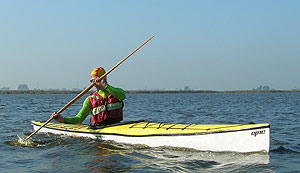After the exercises with the 16X, I continued with the Greenland paddle that I took with me for that purpose.
I was wet anyway, ![]() .
.
Rolling the 16X with the Greenland paddle was easy to do. I got the impression that my movements were faster than normal; may because of the lower resistance of the blade in the water. On pictures afterwards I could see that the working blade was somewhat lower in the water at the end of the roll than with a bigger-bladed conventional paddle. Sounds logical.
Sculling was also no problem, although it requires a much higher frequency of the sculling movements. Sounds also logical regarding the narrow blades. But thinking it over now, I think I will try again later and than use wider strokes. May be more lift is created in that way, making a lower frequency possible.
High brace. To my astonishment this was also easy. I didn't expect that. But later I will try again in kayaks that are heavier to roll up, just to look what happens. On the pictures, made while bracing in the 16X, it could be seen that the blade was rather low on the moment of coming upright, indicating that the blades are rather small for these kind of strokes.
Stern- and bowrudder. Stokes like this are not very effective with the Greenland-paddle. Thinking of paddling in a following sea it requires sometimes an awful lot of power on the sternrudder to keep the kayak running straight, preventing broaching. So I will have to find out later how this paddle performs under real conditions. That will be a double test because it is likely that you end up broaching, needing a high- or low brace to prevent capsizing. We'll see.

Sculling sideways was not very effective in the wind of today trying to move sideways over a certain distance to come in a better position for my photographer. I should tell you that later sculling with the Schlegel wasn't too easy either. Examining the picture I guess I will have to try later again with the purpose to dip the blade deeper in the water.
